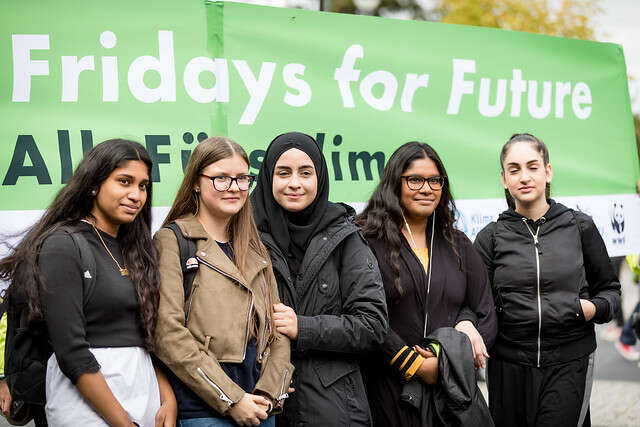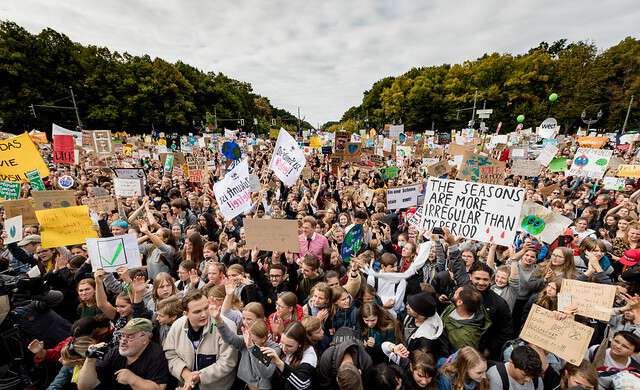Back to Nature: Return to the Body
We are nature – defending itself
The media image of social movements as well as environmental protests is shaped by bodies. Protests as a form of media event make use of bodies as a medium. This can clearly be observed in demonstrations with thousands of people revolting against the transportation of radioactive materials, data surveillance, people coming together for higher wages or against Coronavirus measures not to mention social movements such as Occupy Wall Street and Yellow Vests that are expressing their displeasure about exploitation and social issues. The significance of the body as a means of protest becomes even more evident when it becomes a surface of articulation itself, a banner, a manifesto, as in the spectacular actions of the group Femen, whose activists have attracted media attention with their topless protests since the beginning of the 2010s. It is mostly the female body that articulates and visualizes protest against prevailing social norms, especially since the 1960s. Much rarer, on the other hand, are "moving [...] penises" (Kotte, 2015, p. 1).
The Femen protests, for example, rarely ever include men. A live broadcast by presenter Markus Lanz in 2013, whose talk show at the time dealt with soccer (a so-called male domain), represents an exception. The actions undertaken by two women, dubbed by the media as a "naked protest" (Spiegel, 2013), were directed against the awarding of the 2022 World Cup to Qatar and the serious human rights violations taking place there. Meanwhile, their two male companions wore T-shirts and carried their protest on cardboard signs, thus broadcasting them to the television public. While security men (a real male domain) pushed the women out of the studio, one of the clothed companions was allowed to speak political demands into the microphone. This was a remarkable division of roles, which was probably only able to occur due to the hectic situation in the TV studio.

We are not primarily and exclusively concerned here with the superficial significance of the (naked) body in protests and demonstrations. We are rather more interested in the meaning of the body as a fundamental phenomenological concept, especially in terms of being both a nexus and a difference with regard to both the body and bodiliness. Moreover, we are also interested in the way this philosophical concept is employed by the French philosopher Merleau-Ponty as a means of belonging to the world (Schuhmacher-Chilla, Doris, cf. Merleau-Ponty, 1966 and 1986) and how bodiliness enables and delineates knowledge.
Social protests are also always protests of the body. However, following a medial law of nature, their visibility is increased by means of sensation (sensory perception, the attraction of attention): "Without a visible protest there can be no social movement." (Roth & Rucht, 2008, p. 26). The body is an instrument of political and artistic protests - sometimes clothed and, at times, naked. Whether the protest happens to be against war or repression, you just need to think of the iconic photo of that heroic person in front of the tank column on Tiananmen Square in Beijing to grasp this idea. Other examples include the fight against sexism, discrimination, racism and social conventions, above all exemplified by those protests carried out by members of the ‘68 movement.
Whether it happens to be animal rights activists, environmentalists, cyclists or family doctors - there are protests everywhere involving a lot of physical effort. And since the calculatedly provocative appearances of the Ukrainian Femen activists, increasingly skin has been involved. Such protests are more interesting than those involving the pure act of "stripping naked," which follows the logic of the attention-oriented nature of the media and a consumer society, which are both already saturated with advertising. These protests put pornography to good use, as seen, for instance, when environmental activists copulate in public or, as the case may be, online in order to raise money for the preservation of the rainforest (e.g. Fuck for Forest). All of this seems to correspond to the above-mentioned "division of roles." In this connection, many questions can be raised regarding gender, diversity and the preservation of (ecological) biodiversity.
Especially in environmental protests, activists use their bodies: occupying trees like in the Dannenröder Forest in Hesse, spectacular rappelling events and being chained to train tracks on nuclear waste routes. Inherent in such spectacular actions is always the issue of "gender constructions in environmental discourses" (Bauriedl, 2015, p. 101) and the scope of "gender dualisms." If "the perception of nature and the use of nature [...] [as well as the destruction of nature, the author] are in turn conditioned by socially normed gender roles and vice versa [...] gender relations [produce] specific structures of social nature relations" (Bauriedl, 2015, p. 101), then environmental protests cannot function without a debate occurring focusing on diversity and gender.

One term in particular that has been making the rounds in Germany for some years now suggests precisely this: biodiversity. It refers to biological diversity - the diversity of ecosystems, the diversity of species and the genetic diversity found within species. The extinction of species and ecosystems on account of the climate crisis has made this term popular. The diversity discourse and the debate about ecological biodiversity have numerous points of reference (see Katz, 2020). Nevertheless, the connection between biodiversity and gender relations as well as diversity is largely overlooked in these debates, which for the most part are dominated by economic issues (cf. Schmitz, 2008, p. 17). The power and dependency relations in male-female relationships - whose analysis remains largely entrenched in a form of gender dualism - are hardly ever examined when it comes to the use, access and control of resources as well as the protection of the environment. In countries of the global South, but also in those of the North, women are still mainly responsible for providing for their families in terms of basic food needs.
However, the ecological and economic discourses are dominated by (white) men. In practice, they are the ones exploiting the planet at the same time. Social dimensions tend to be mostly ignored. Even more so, the field lies fallow when it comes to more complex concepts, such as gender and diversity issues for instance. (When relationships of inequality happen to be found in such a complex manner, then an intersectional approach is required). It is important to trace the interactions and entanglements of different dimensions of inequality and to link together social and ecological issues. The discourses on biodiversity, diversity and gender offer various approaches to doing this. Diversity and its visualization, embodiment and recognition is a conditio sine qua non for the conservation of biodiversity and nature. And even if diversity makes what separates more visible, it does end up contributing to understanding, more equality and justice. And yet it does not lead back to the body, i.e. it cannot reverse the degradation of the body in relation to the mind and thus its objectification as an object of research together with its measurement in various types of science. But at the same, in so doing, it exposes the social, economic and ecological mutilations and, along with them, the hope for reassembly and the desire for (spiritual) healing - just as a naked body exposes its wounds. Even if the return to the body cannot be achieved, categorized bodies do open up the possibility of coming to terms with these very differences and thus bringing about a path leading to more equality.
Literature:
Bauriedl, S. (2015). Geschlechterkonstruktionen in Umweltdiskursen – Verfestigung und Aufweichen von Geschlechterdualismen. In (Hrsg.) Katz, C., Hellmann, S., Thiem, A., Moths,K. Koch, L. M. & Hofmeister, S. (Hrsg.), Nachhaltigkeit anders denken. Veränderungspotenziale durch Geschlechterperspektiven (S. 101-113). Springer.
Horkheimer, M. & Adorno, T. W. (1969). Dialektik der Aufklärung - Philosophische Fragmente. Fischer Verlag.
Katz, C. (2020). Funktionalität und Störung in der Ökologie: Eine genderanalytische Betrachtung. Studie, Teil 3, im Rahmen des Projektes „Caring for natures?“ Geschlechterperspektiven auf (Vor-)Sorge im Umgang mit „Natur/en“. https://www.diversu.org/wp-con...
Kotte, H.-H. (2015, 20. Februar). Das ist doch blanker Aktionismus. Raus aus den Klamotten, rein in den Protest. Blank zu ziehen, ist bei politischen Aktivisten seit jeher ein beliebter Aufmerksamkeitsbeschleuniger. fluter. Magazin der Bundeszentrale für politische Bildung. https://www.fluter.de/das-ist-...
Lindemann, G. (2017) Leiblichkeit und Körper. Gugutzer R., Klein G., Meuser M. (Hrsg.) Handbuch Körpersoziologie. Springer VS. https://doi.org/10.1007/978-3-...
Lippe, R. zur (1988). Vom Leib zum Körper. Naturbeherrschung am Menschen in der Renaissance. Rowohlt.
Roth, R. & Rucht, D. (Hrsg.) (2008). Die sozialen Bewegungen in Deutschland seit 1945 - Ein Handbuch. Campus Verlag.
Schmitz, J. (2008). Gender, Klimawandel und Biodiversität. Zusammenhänge zwischen Klimawandel und Geschlechterverhältnissen. arranca!, 38 (S. 17-18). https://arranca.org/archive?pa...
Spiegel (2013, 12. Dezember). Nackter Protest gegen Fußball-WM in Katar. https://www.spiegel.de/panoram...
Write comment
Your email address will not be published. Comments are published only after moderation.
Comments ()